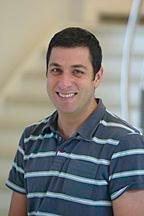A team of scientists at the University of Southampton, U.K. have developed a molecule that acts as an exercise mimic, and shows potential to help in treating type 2 diabetes and obesity.
The molecule, currently called compound 14, inhibits the function of the cellular enzyme ATIC, which functions in metabolism as an agent of accumulation of a molecule called ZMP in cells. This increase in ZMP makes cells “think” they’ve run out of energy by activating the cell’s central energy sensor, known as AMPK, thereby causing cells to try and increase their energy levels by increasing glucose uptake and metabolism.
A paper published in the journal Chemistry and Biology describes how the researchers found that activating AMPK with compound 14 leads to a reduction in fasting blood glucose levels, improved glucose tolerance and at the same time promoted weight loss in obese mice.
The Open Access paper, entitled “AMPK Activation via Modulation of De Novo Purine Biosynthesis with an Inhibitor of ATIC Homodimerization“ is coauthored by Daniel J. Asby, Francesco Cuda, Maxime Beyaert, Franchesca D. Houghton, Felino R. Cagampang, and Ali Tavassoli, with Open Access funding by the Engineering and Physical Sciences Research Council.
The paper describes how AICAR transformylase is targeted in cells with an ATIC homodimerization inhibitor, with the resulting increase in endogenous Aminoimidazole-4-carboxamide ribonucleotide (AKA ZMP) sufficient to activate AMPK. Downstream AMPK signaling is also activated, significantly altering cell metabolism, and a mouse model of metabolic syndrome is used to show therapeutic viability.
The researchers demonstrate that endogenous ZMP, produced by the aforementioned metabolic pathways, is also capable of activating AMPK, and go on to illustrate the viability of using this approach to AMPK activation as a therapeutic strategy with an in vivo mouse model for metabolic disorders.
 Senior coauthor Ali Tavassoli the Professor of Chemical Biology at the University of Southampton whose research team discovered and developed compound 14, says: “There is a lot of evidence from previous studies that if you could selectively activate AMPK with a small molecule, it could have potential benefits in the treatment of several diseases, including type 2 diabetes, by acting as an exercise mimetic and increasing the uptake and usage of glucose and oxygen by cells. Our molecule, which activates AMPK by altering cellular metabolism, therefore holds much promise as a potential therapeutic agent.”
Senior coauthor Ali Tavassoli the Professor of Chemical Biology at the University of Southampton whose research team discovered and developed compound 14, says: “There is a lot of evidence from previous studies that if you could selectively activate AMPK with a small molecule, it could have potential benefits in the treatment of several diseases, including type 2 diabetes, by acting as an exercise mimetic and increasing the uptake and usage of glucose and oxygen by cells. Our molecule, which activates AMPK by altering cellular metabolism, therefore holds much promise as a potential therapeutic agent.”
Dr. Tavassoli currently leads an interdisciplinary team of scientists whose research efforts are focused on development of novel chemical tools that can enable new insights into the role of protein-protein interactions in cell biology, and as the starting point for new therapeutics.
The main focus of the Tavassoli lab is identification of cyclic peptide inhibitors of protein-protein interaction using a genetically encoded high-throughput screening platform. The research team’s goal is development of compounds capable of disrupting the association and assembly of protein complexes. The compounds uncovered in their lab serve as valuable tools that allow better understanding of the role of individual protein-protein interactions in cells. These compounds also form the starting point for the development of therapeutic compounds that target key protein-protein interactions in disease. The research group is focused on training scientists at the chemistry-biology interface, and using these interdisciplinary skills to help understand the fundamentals of cell biology and to develop new therapeutic agents.
In early encouraging tests, the compound 14 molecule was given to two groups of mice who were fed either a normal diet or a high-fat diet that caused them to become obese and impaired their glucose tolerance (one of the clinical signs of pre-diabetes). When mice with a normal diet were treated with compound 14, their blood glucose levels and weight remained normal. However, in obese mice on the high-fat diet, a single dose of compound 14 resulted in their elevated blood glucose returning to near-normal levels. Furthermore, a daily dose of compound 14 administered to the obese mice for seven days resulted in improved glucose tolerance and 1.5 grams weight loss (about five percent body weight). Compound 14 did not affect the weight of control mice on the normal diet.
The next step for the researchers is to develop the molecule further in order to examine the effect of long-term treatment and its mode of action in improving glucose tolerance and in reducing body weight. If found to be safe, a drug could be developed to help persons with diabetes and obesity manage their condition.
 Dr. Felino Cagampang, Associate Professor in Integrative Physiology at the University of Southampton and study co-author, observes: “Current treatments for type 2 diabetes centers on elevating circulating insulin levels or improving the insulin sensitivity of an individual. The issue is that established drugs do not successfully enable patients with type 2 diabetes to achieve glycaemic control and some can even result in weight gain, a leading factor driving the diabetes epidemic. In contrast, this new molecule seems to reduce glucose levels and at the same time decrease body weight, but only if the subject is obese.”
Dr. Felino Cagampang, Associate Professor in Integrative Physiology at the University of Southampton and study co-author, observes: “Current treatments for type 2 diabetes centers on elevating circulating insulin levels or improving the insulin sensitivity of an individual. The issue is that established drugs do not successfully enable patients with type 2 diabetes to achieve glycaemic control and some can even result in weight gain, a leading factor driving the diabetes epidemic. In contrast, this new molecule seems to reduce glucose levels and at the same time decrease body weight, but only if the subject is obese.”
Dr. Cagampang’s current research focuses on developmental programming of obesity and the metabolic syndrome (i.e. a clustering of cardiometabolic risk factors that include obesity and having fatty liver, elevated blood pressure, insulin resistance and glucose intolerance, dyslipidemia, being in a proinflammatory and prothrombic state). His research is funded by the Biotechnology and Biological Sciences Research Council (BBSRC), the Medical Research Council (MRC) and Diabetes UK. Dr Cagampang’s research group is based at the Institute of Developmental Sciences (Southampton General Hospital site), and comprises both clinical and basic scientist and researchers, as well as postgraduate and medical students.
Sources:
University of Southampton
The Journal of Chemistry and Biology
Image Credits:
University of Southampton


